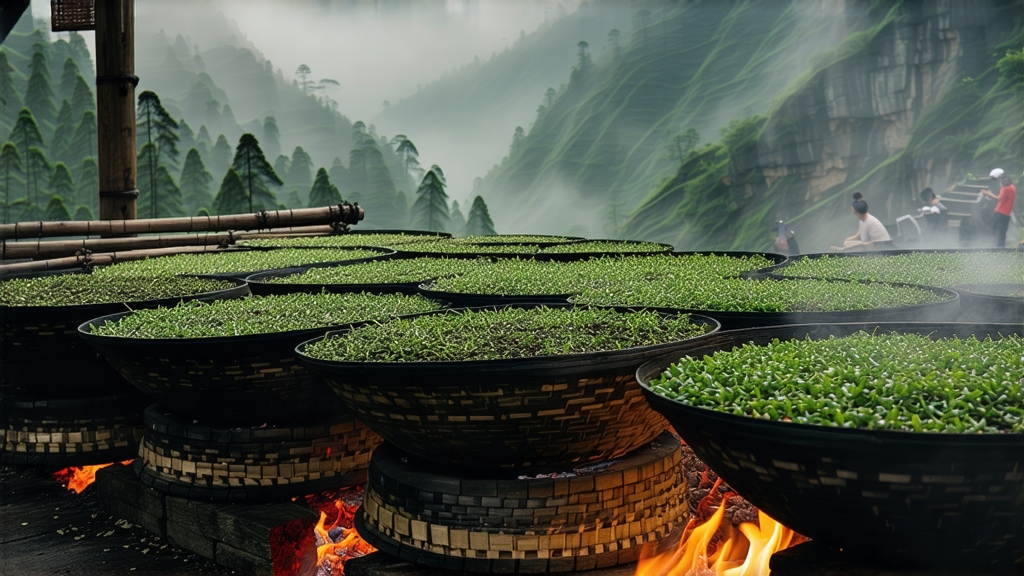
Long before English breakfasts were sweetened with milk and sugar, a small village in China’s Wuyi Mountains accidentally created the black tea that would later inspire Earl Grey blends, Russian caravan teas, and the entire Western obsession with “bohea.” That village is Tongmu Guan, and the tea is Lapsang Souchong—today celebrated as the oldest documented black tea on earth. To international drinkers the name often evokes a smoky curiosity sipped once and remembered forever; to Chinese growers it is a protected geographical indication whose authenticity is guarded as fiercely as Champagne in France. This article invites you to travel beyond the campfire scent and discover why Lapsang Souchong remains both a historical monument and a living, evolving craft.
-
From Green to Black: A 17th-Century Accident
Late-Ming soldiers, the story goes, camped among tea factories during harvest season. Their presence delayed the usual green-tea processing; fresh leaves withered too long, oxidised, and turned a coppery red. To save the crop, farmers rushed the leaves over available pine fires, drying them quickly for market. The Europeans waiting at the port of Xiamen loved the dark colour and long shelf life, and “black tea” was born—literally translated from the Dutch “zwarte thee.” By 1604 Dutch traders were shipping it to Amsterdam; by 1662 Catherine of Braganza made it fashionable at the English court. Thus Lapsang Souchong became the prototype for every black tea that followed. -
Terroir in the National Reserve
Authentic Lapsang Souchong can only be produced inside the 565 km² core zone of the Wuyi National Nature Reserve, Fujian Province. The canyon village of Tongmu Guan sits at 27° N latitude, 200–1200 m above sea level, wrapped in cloud 220 days a year. The humid microclimate nurtures a special sub-species of tea bush—Xiao Ye Zhong (small-leaf variety)—whose leaves are unusually low in bitterness and high in floral saccharides. Rocky, acidic soil drains quickly, forcing roots to struggle and concentrate aromatic compounds. Even the local Masson pine (Pinus massoniana) contains more resin than northern cousins, providing the signature smoke. In 2002 the Chinese government granted Tongmu Guan PGI status; leaves picked outside, no matter how expertly smoked, cannot legally bear the name Lapsang Souchong. -
Two Families, Two Styles
Walk the single stone street of Tongmu Guan today and you will meet two lineages with distinct recipes.
Traditional Pinewood Style (Zheng Shan Xiao Zhong)
• Pluck one bud, two leaves before Qingming festival.
• Wither 8–10 h on bamboo racks inside wooden lofts above slow-burning pine embers; smoke permeates the withering leaf.
• Roll for 45 min until cell walls rupture and juices oxidise.
• Ferment 3 h at 28 °C, 85 % humidity; leaf turns chocolate brown.
• Bake three times over fresh pinewood fires, 90 °C, 20 min each; residual moisture falls below 3 %.
The result is glossy, midnight-black strips with a tarry, pine-tar bouquet and a sweet, longan finish.
Modern Unsmoked Style (Wu Yan Xiao Zhong)
Driven by contemporary Chinese preference for clean, honey-like aromas, many Tongmu artisans now skip the final smoking. They wither leaves naturally in shaded corridors, oxidise fully, then bake in electric ovens at 80 °C. The liquor is russet, not mahogany, tasting of dried apricot, malt, and a hint of narcissus—proving that the Wuyi terroir alone can stand without its historic smoke cloak.
-
Craft Details That Matter
Smoke Timing: Only young pine branches cut during the dormant season (Dec–Feb) are used; sap content is highest, giving a sweet, resinous smoke rather than a harsh creosote.
Fire Temperature: Below 90 °C; higher heat burns leaf sugars and creates bitterness.
“Ma” Drying: A final 30-second blast at 120 °C locks in a subtle crackling note locals compare to toasted sesame (“ma”). -
Brewing the Perfect Cup
Western Ratio: 3 g leaf per 250 ml water, 95 °C,